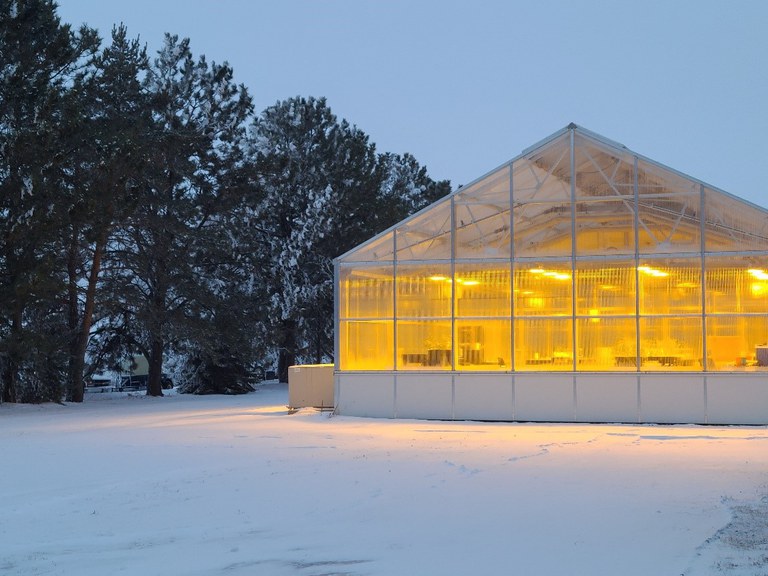What’s Going On in the Greenhouse?
CREC is fortunate in that it has access to a state-of-the-art greenhouse facility. This means that crops research can continue even when there is snow outside (Figure 1). This space has been utilized for various projects over the years, but here is a look at a few projects occurring this winter.
 Figure 1. Greenhouse complex utilized by the Carrington Research Extension Center.
Figure 1. Greenhouse complex utilized by the Carrington Research Extension Center.
Cover crop tolerance to residual herbicides. The objective of this study was to grow numerous cover crops and document injury symptoms from herbicide carryover. In this study Pursuit, Widematch, and Acuron were applied at 3 micro-rates of each product ranging from 0.5x, 0.125x, and 0.03x of field use-rates. Eight cover crop species were weighed and photographed at the end of the study.
Rye allelopathy to cash crops. This study was designed to try isolate allelopathic properties of rye from competitive properties. Two rye varieties and one winter wheat variety were tested together (same pot) or separate (2 pots, but same area as 1 pot) from sunflowers, soybeans, and flax. Preliminary results indicate that sunflower biomass was reduced 26-30% when grown together with rye (compared to grown separately). Winter wheat reduced sunflower biomass by 16%. Winter wheat reduced soybean biomass more than the two rye varieties (22 vs 10% reduction) when grown together. Flax saw a flax 14% reduction regardless of cereal companion.
Evaluation of flax variety tolerance to fusarium wilt. The objective of this experiment is to assess the tolerance of 10 flax varieties to fusarium wilt. Fusarium wilt is a seedling disease of flax that often is overlooked as producers implement flax production practices. Most flax varieties are rated as moderately resistant (MR) to the disease. However, in 2020 we observed high levels of infection among varieties within the variety trial, many that are rated as MR for the disease. This greenhouse trial is our attempt to provide additional information related to how different flax varieties tolerate potential infections due to fusarium wilt. Figure 2 is a display of flax disease response occurring in the greenhouse.
 Figure 2. Flax displaying disease symptoms in the greenhouse.
Figure 2. Flax displaying disease symptoms in the greenhouse.
Sorghum improvement. Sorghum germplasm has been grown in field studies near Carrington since 2016. The best performing lines are being crossed in the greenhouse to develop some northern hardy sorghum varieties.
Cover crop precision agriculture. Cover crop species are being screened for tolerance to soil characteristics typical of topography change in North Dakota. Six samples of soil were taken across an elevation gradient which differ in CCE (calcium carbonate equivalency). The controlled setting of the greenhouse allows us to remove moisture differences from the screening process to determine which cover crops respond to changes in soil carbonate concentrations.
Mike Ostlie
Mike.Ostlie@ndsu.edu
Assistant Director and Agronomist
Blaine Schatz
Blaine.Schatz@ndsu.edu
CREC Director and Agronomist


